Suwari-Waza Kosa-dori Dai-Ikkyo
Ude-osae
Demonstrated and explained by Kanetsuka Sensei
|
|

Photos and text: Peter Megann
Graphics and typesetting: Graham and Laura Jones
Uke: Richard Martin
|
Kosa-dori Dai-lkkyo is particularly important for studying te-sabaki (hand movement) not only in the execution of Dai-lkkyo but of many techniques.
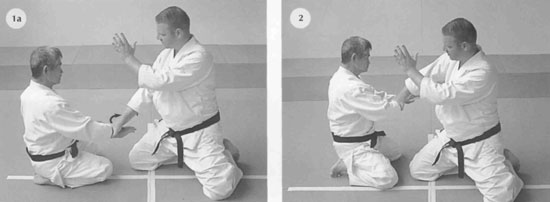
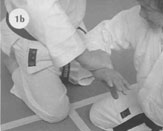 Photos 1a & b: With his right hand
Uke grasps Tori's right wrist and
threatens to strike Tori's head with his other hand (though there are various other ways in which he can attack
after taking Ton's wrist). Tori's thumb starts to turn inwards, pointing towards his nose, and with this
turning of the wrist the forearm is twisting like a coil and the elbow begins to rise naturally
outwards. There is a feeling of tension between Ton's centre and Uke's, like when drawing a bow with an arrow. At this first
contact, Tori's movement starts at his wrist, then expands like a wave to his elbow and then to his shoulder. The shoulder and
arm should be relaxed and the movement should be of a sinuous nature.
Photos 1a & b: With his right hand
Uke grasps Tori's right wrist and
threatens to strike Tori's head with his other hand (though there are various other ways in which he can attack
after taking Ton's wrist). Tori's thumb starts to turn inwards, pointing towards his nose, and with this
turning of the wrist the forearm is twisting like a coil and the elbow begins to rise naturally
outwards. There is a feeling of tension between Ton's centre and Uke's, like when drawing a bow with an arrow. At this first
contact, Tori's movement starts at his wrist, then expands like a wave to his elbow and then to his shoulder. The shoulder and
arm should be relaxed and the movement should be of a sinuous nature.
Photo 2: Coming up onto his toes Tori slides his left knee to the side. At the same time he raises his right arm, protecting his head (furi-kaburi). With one movement you have to protect yourself and control your partner: defence and attack happen at the same time. Both arms have the round, extended feeling of the suwari-waza kokyu-ho exercise. Even though his left arm is not yet making contact it is nevertheless engaged in the movement - not hanging inactive by his side. Tori's right hand continues to circle Uke's wrist, the thumb pointing to his (Tori's) left shoulder. The contact with Uke's wrist is through Ton's 'hand-blade'.
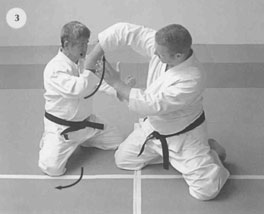 Photo 3: Tori changes direction, his right knee sliding slightly to the right. I3e careful not to push your partner during stages 1 - 3. You should simply move around the contact point (the point where you are gripped). In Photo 3 Tori brings his left shoulder closer to his hand, while continuing to raise and turn outwards his right wrist. The effect of this is to bring Uke's elbow up so that his balance starts to be disturbed. After making atemi with his left hand Tori brings it up to make contact with Uke's arm just above the elbow. At the same time Ton's right wrist and hand are continuing to revolve against Uke's right wrist, like a differential gear, the thumb pointing down now. It is important that both your hands work in unison. Notice how Uke's right elbow has been brought up.
Photo 3: Tori changes direction, his right knee sliding slightly to the right. I3e careful not to push your partner during stages 1 - 3. You should simply move around the contact point (the point where you are gripped). In Photo 3 Tori brings his left shoulder closer to his hand, while continuing to raise and turn outwards his right wrist. The effect of this is to bring Uke's elbow up so that his balance starts to be disturbed. After making atemi with his left hand Tori brings it up to make contact with Uke's arm just above the elbow. At the same time Ton's right wrist and hand are continuing to revolve against Uke's right wrist, like a differential gear, the thumb pointing down now. It is important that both your hands work in unison. Notice how Uke's right elbow has been brought up.
 Photo 4: With the combined movement of both arms, just as in the suwari-waza kokyu-ho exercise, Tori brings Uke's arm in a wide arc down to a point in front of his navel. During this movement Tori rolls Uke's wrist outwards and downwards. Avoid dragging your partner. There is no need to grip strongly with either hand: just maintain contact and tension. The action through Photos 1 - 4 should be one of an unbroken arc.
Photo 4: With the combined movement of both arms, just as in the suwari-waza kokyu-ho exercise, Tori brings Uke's arm in a wide arc down to a point in front of his navel. During this movement Tori rolls Uke's wrist outwards and downwards. Avoid dragging your partner. There is no need to grip strongly with either hand: just maintain contact and tension. The action through Photos 1 - 4 should be one of an unbroken arc.
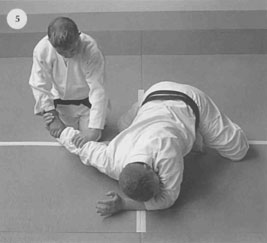
Photos 5 & 6: Pivoting on his right knee Tori advances his left hip and slides his left knee forwards towards Uke's right armpit. He moves with shikko, keeping his heels together.
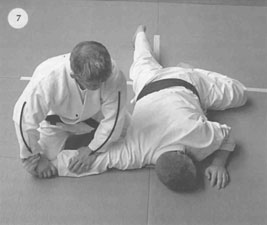 Photo 7: Pivoting on his left knee Tori slides his right knee forwards and brings it into contact with his right wrist and with Uke's arm just above the wrist. It is important that Uke's arm is brought to rather more than 90° to his body. Tori is sitting up onto his toes (kiza), putting his weight on his heels, his tanden (lower belly) is thrust forwards and his spine is slightly concave. His feet and two knees form a triangle like a tripod. He expands his tanden and opens his knees with a stretching feeling. His right knee is inside his gripping hand, as though locking it, his left knee is in contact with Uke's upper ribs by the armpit. Tori is stretching Uke's arm, pinning the inside of his elbow to the tatami. Breathing out Tori rocks forwards, bringing his weight to bear through the heel of his hand on the ligament just above Uke's elbow. The heel of his right hand is in contact with the pulse area of Uke's wrist. There is no need to grip strongly with either hand. You control your partner by shifting your weight, not through the power of your grip. Don't look down as you finish: concentrate your eyes on a spot several feet in front of you.
Photo 7: Pivoting on his left knee Tori slides his right knee forwards and brings it into contact with his right wrist and with Uke's arm just above the wrist. It is important that Uke's arm is brought to rather more than 90° to his body. Tori is sitting up onto his toes (kiza), putting his weight on his heels, his tanden (lower belly) is thrust forwards and his spine is slightly concave. His feet and two knees form a triangle like a tripod. He expands his tanden and opens his knees with a stretching feeling. His right knee is inside his gripping hand, as though locking it, his left knee is in contact with Uke's upper ribs by the armpit. Tori is stretching Uke's arm, pinning the inside of his elbow to the tatami. Breathing out Tori rocks forwards, bringing his weight to bear through the heel of his hand on the ligament just above Uke's elbow. The heel of his right hand is in contact with the pulse area of Uke's wrist. There is no need to grip strongly with either hand. You control your partner by shifting your weight, not through the power of your grip. Don't look down as you finish: concentrate your eyes on a spot several feet in front of you.
The essence of Ikkyo is to bring your partner face down and pin him/her to the tatami through the elbow.
2. Application: Defence against tsuki
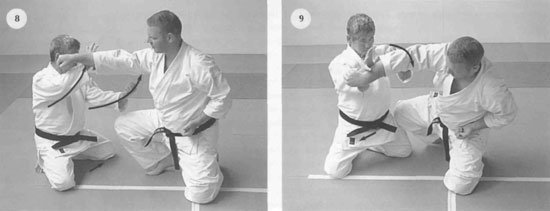
Photo 8: (Uke takes a shikko step forwards and makes tsuki to Ton's face. Instantly Tori conies up into kiza and moves off the attacking line to his left, sliding his left knee and raising his right hand to protect his head and neck and at the same time attacking Uke's armpit with his left hand. He makes contact with Uke's arm with his right hand-blade. Do not try to take hold or block at this moment. This contact is like when you start suwari-waza kokyu-ho and bring your partner up.
Photo 9: Rotating his body to his right Tori makes contact with Uke's elbow with the heel of his hand, his thumb pointing downwards and lightly gripping the inside of Uke's arm. Ton's weight is beginning to shift onto his right knee. The action of his hands in conjunction with the rotation of his body unbalances Uke and turns him over.
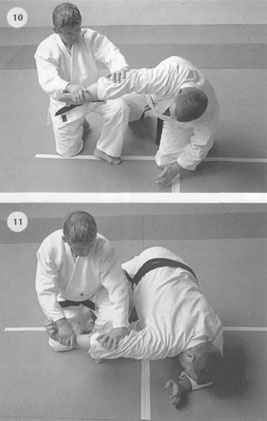 Photo 10: Changing direction, Tori thrusts towards Uke's armpit. Because of the height of Uke's attacking arm in this instance he has brought his left knee up. But his body is not rising up: more a feeling of kicking. His energy is flowing from the toes of both feet.
Photo 10: Changing direction, Tori thrusts towards Uke's armpit. Because of the height of Uke's attacking arm in this instance he has brought his left knee up. But his body is not rising up: more a feeling of kicking. His energy is flowing from the toes of both feet.
Photos 11 & 12: As Tori brings his left knee to the tatami, he slides his right knee towards the wrist of his right hand, which is now gripping Uke's wrist. The finish is the same as explained in Photo 7.
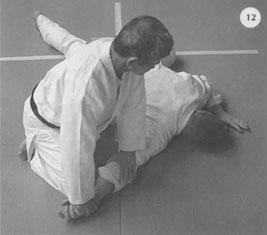



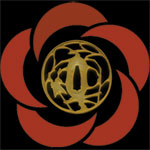


 Photos 1a & b: With his right hand
Photos 1a & b: With his right hand
 Photo 3:
Photo 3:  Photo 4: With the combined movement of both arms, just as in the
Photo 4: With the combined movement of both arms, just as in the  Photo 7: Pivoting on his left knee
Photo 7: Pivoting on his left knee 
 Photo 10: Changing direction, Tori thrusts towards
Photo 10: Changing direction, Tori thrusts towards